PONTIAC PONTIAC 1997 Owners Manual
Manufacturer: PONTIAC, Model Year: 1997, Model line: PONTIAC, Model: PONTIAC PONTIAC 1997Pages: 419, PDF Size: 19.67 MB
Page 261 of 419
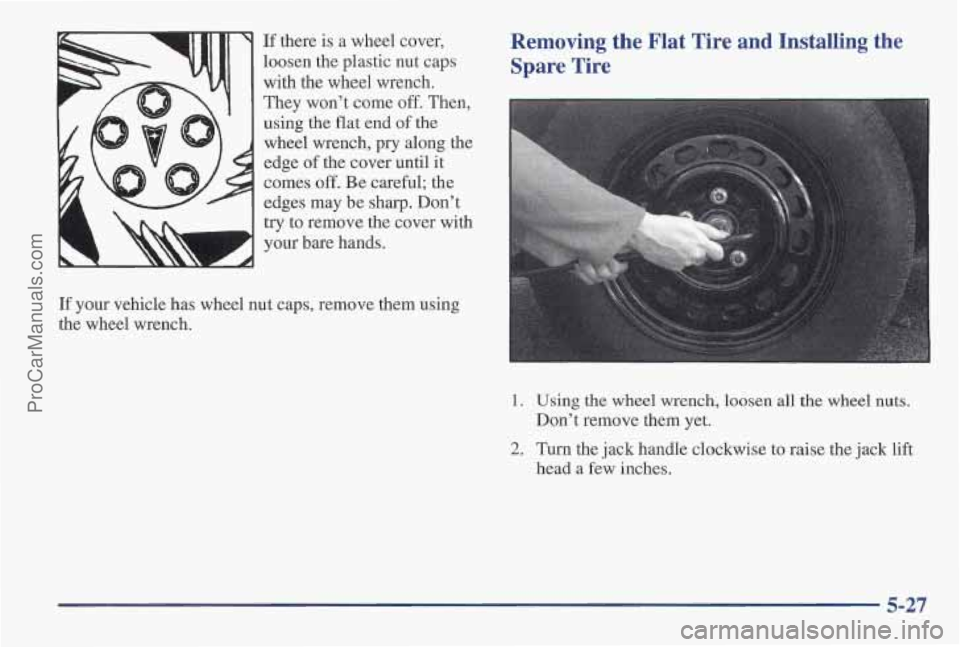
If there is a wheel cover,
loosen the plastic nut caps
with the wheel wrench.
They won’t come off. Then, using the flat end
of the
wheel wrench, pry along the
edge of the cover until it
comes off. Be careful; the
edges may be sharp. Don’t
try to remove the cover with
your bare hands.
Removing the Flat Tire and Installing the
Spare Tire
If your vehicle has wheel nut caps, remove them using
the wheel wrench.
1. Using the wheel wrench, loosen all the wheel nuts.
Don’t remove them yet.
2. Turn the jack handle clockwise to raise the jack lift
head
a few inches.
5-27
ProCarManuals.com
Page 262 of 419
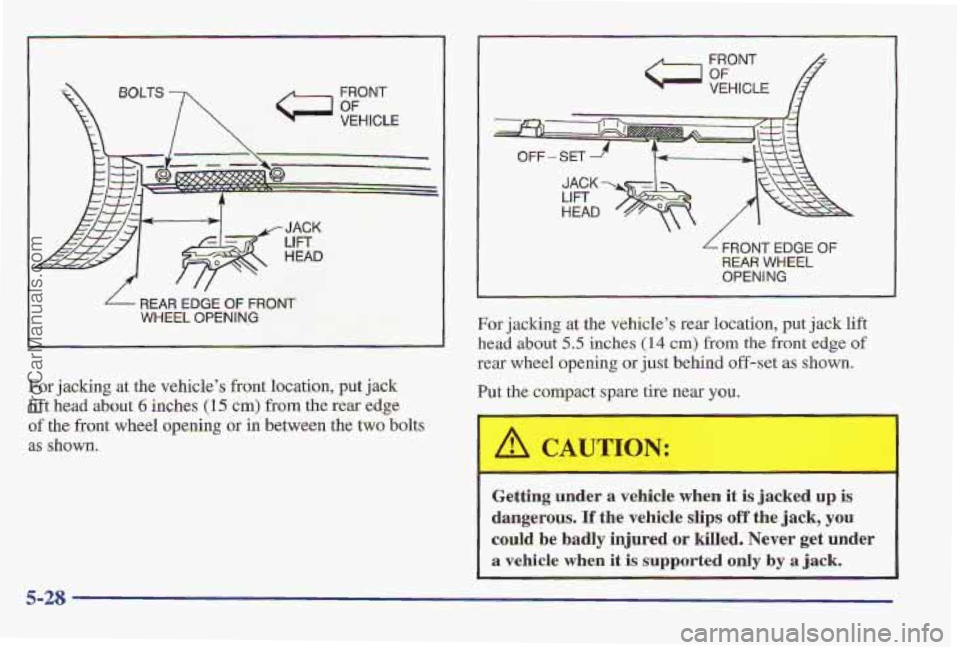
FRONT
VEHICLE
REAR EDGE OF FRONT
WHEEL OPENING
For jacking at the vehicle's front location, put jack
lift head about 6 inches (15 cm> from the rear edge
of the front wheel opening or in between the two bolts
as
shown.
L?ONT VEHICLE /-
FRONT EDGE OF
REAR WHEEL
OPEN1
NG
For jacking at the vehicle's rear location, put jack lift
head about 5.5 inches (14 cm) from the front edge of
rear wheel opening or just behind off-set as shown.
Put the
compact spare tire near you.
I
Getting under a vehicle when it is j ked up is
dangerous.
If the vehicle slips off the jack, you
could be badly injured or killed, Never get under
a vehicle when it is supported only by a jack.
5-28
ProCarManuals.com
Page 263 of 419
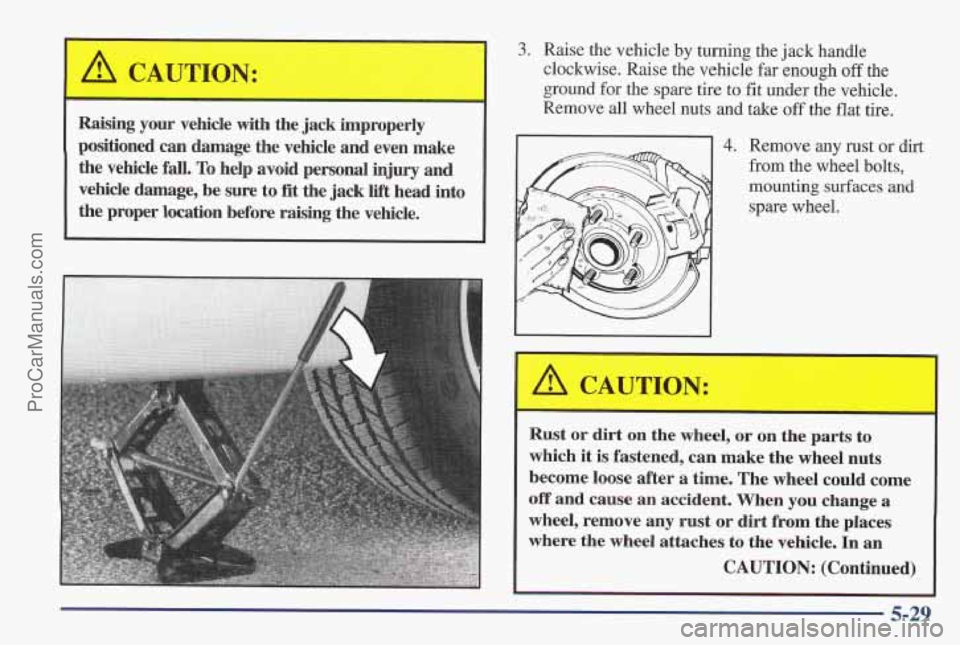
& CAUTION:
- -
Raising your vehicle with the jack i
positioned can damage the vehicle and even make
the vehicle fall. To help avoid personal injury and
vehicle damage, be sure
to fit the jack lift head into
the proper location before raising the vehicle.
3. Raise the vehicle by turning the jack handle
clockwise. Raise the vehicle far enough off the
ground for the spare tire to fit under the vehicle.
Remove all wheel nuts and take off the flat tire.
4. Remove any rust or dirt
from the wheel bolts,
mounting surfaces
and
spare wheel.
Rust or dirt on the wheel, or on the parts to
which it is fastened, can make the wheel nuts
become loose after a time. The wheel could come
off and cause an accident. When you change a
wheel, remove any rust or dirt from the places
where the wheel attaches to the vehicle.
In an
CAUTION: (Continued)
5-29
ProCarManuals.com
Page 264 of 419
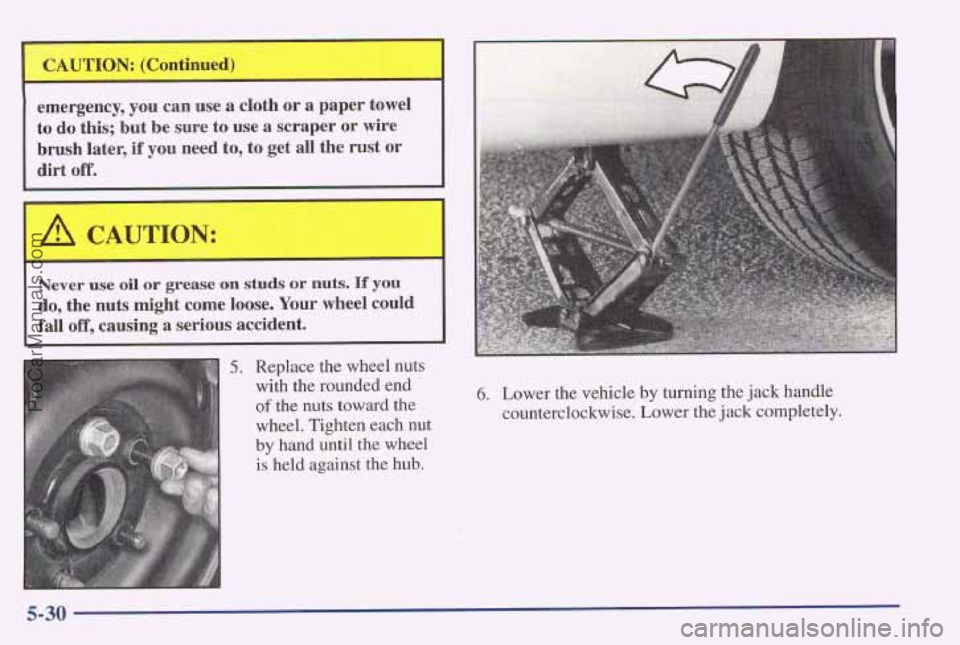
CAUTION: (Continued)
emergency, you can use a cloth
or a paper towel
to
do this; but be sure to use a scraper or wire
brush later, if you need to, to get all the rust or
dirt off.
I
Never use oil or grease on studs or nuts. If you
do, the nuts might come loose. Your wheel could
fall
off, causing a serious accident.
5. Replace the wheel nuts
with the rounded end
of the nuts toward the
wheel. Tighten each nut
by hand until the wheel
is held against the hub.
6. Lower the vehicle by turning the jack handle
counterclockwise. Lower the jack completely.
ProCarManuals.com
Page 265 of 419

7. Tighten the wheel nuts
firmly in
a crisscross
sequence as shown.
Incorrect wheel nuts or improperly tightened
wheel nuts can cause the wheel to become loose
and even come off. This could lead
to an accident.
Be sure to use the correct wheel nuts.
If you have
to replace them, be sure to get new GM original
equipment wheel nuts.
Stop somewhere as soon as you can and have
the nuts tightened with
a torque wrench to
100 Ib-ft (140 Nom). ’
NOTICE:
Improperly tightened wheel nuts can lead to
brake pulsation and rotor damage.
To avoid
expensive brake repairs, evenly tighten the wheeI
nuts in the proper sequence and to the proper
torque specification.
Don’t try to put the wheel cover on your compact
spare tire.
It won’t fit. Store the wheel cover in the
trunk until you have th’e flat tire repaired or replaced.
NOTICE:
Wheel covers won’t fit on your compact spare. If
you try to put a wheel cover on your compact
spare, you could damage the cover or the spare.
5-31
ProCarManuals.com
Page 266 of 419
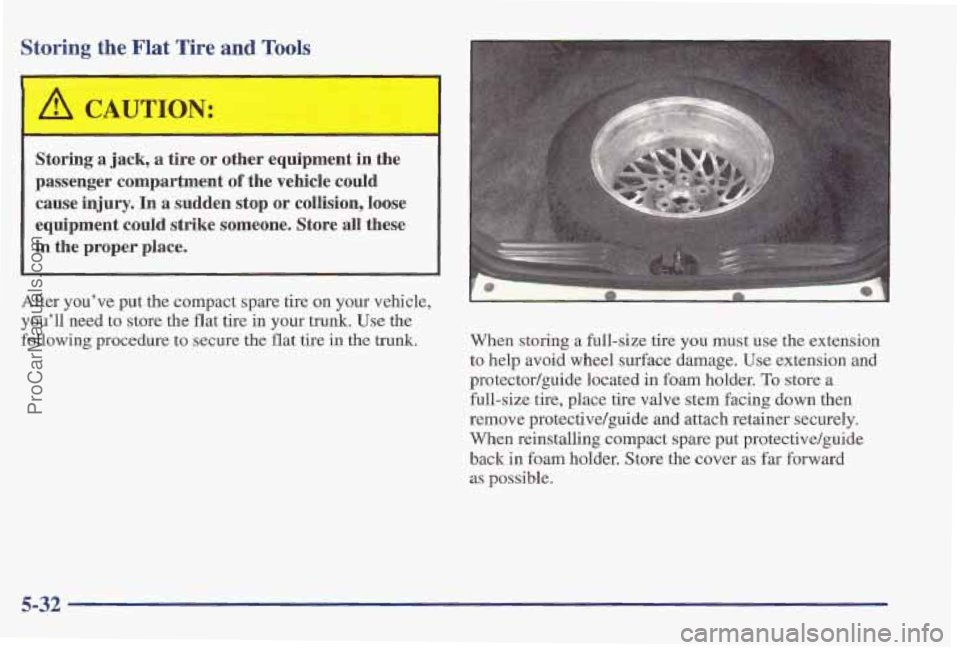
Storing the Flat Tire and Tools
Storing a jack, a tire or other equipment in the
passenger compartment
of the vehicle could
cause
injury. In a sudden stop or collision, loose
equipment could strike someone. Store
all these
in the proper place.
After you’ve put the compact spare tire on your vehicle,
you’ll need to store the flat tire in your trunk. Use the
following procedure
to secure the flat tire in the trunk. When storing a full-size tire you must use the extension
to help avoid wheel surface damage. Use extension and
protector/guide located in foam holder.
To store a
full-size tire, place tire valve stem facing down then
remove protectivelguide and attach retainer securely.
When reinstalling compact spare put protective/guide
back in foam holder. Store the cover
as far forward
as possible.
5-32
ProCarManuals.com
Page 267 of 419
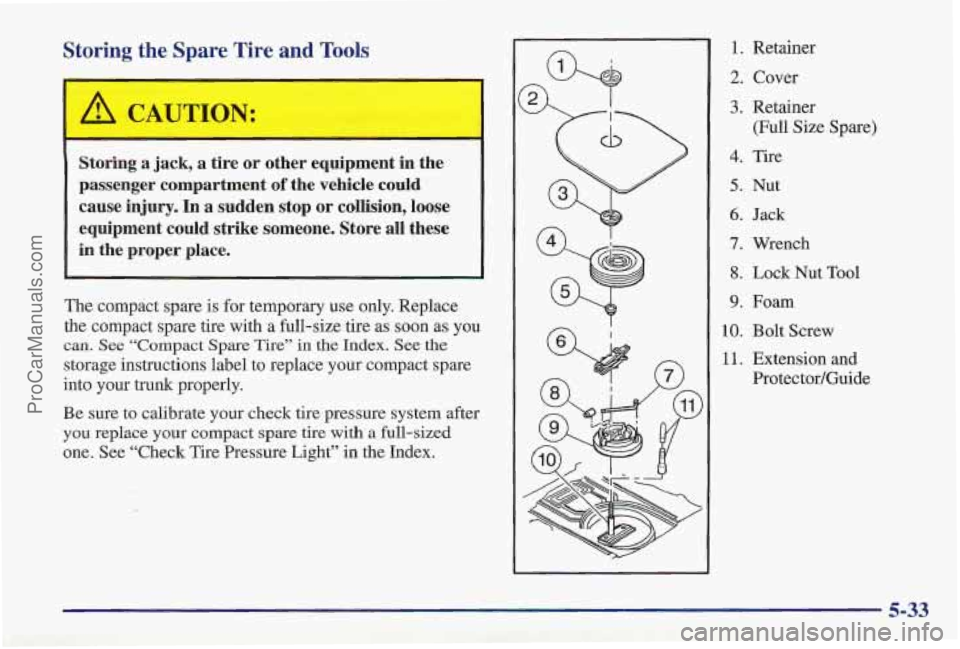
Storing the Spare Tire and Tools
1
I
Storing a jack, a tire or ‘other equipment in the
passenger compartment
of the vehicle could
cause injury. In a sudden stop or collision, loose
equipmen.t could strike someone. Store all these in the proper place.
The compact spare is for temporary use only. Replace
the compact spare tire with a full-size tire as soon as you
can. See “Compact Spare Tire” in the Index. See the
storage instructions label to replace your compact spare
into your trunk properly.
Be sure to calibrate your check tire pressure system after
you replace your compact
spare tire with a full-sized
one. See “Check Tire Pressure Light” in the Index.
I
1. Retainer
2. Cover
3. Retainer
(Full Size
Spare)
4. Tire
5. Nut
6. Jack
7. Wrench
8. Lock Nut Tool
9. Foam
10. Bolt Screw
11. Extension and
Protector/Guide
5-33
ProCarManuals.com
Page 268 of 419
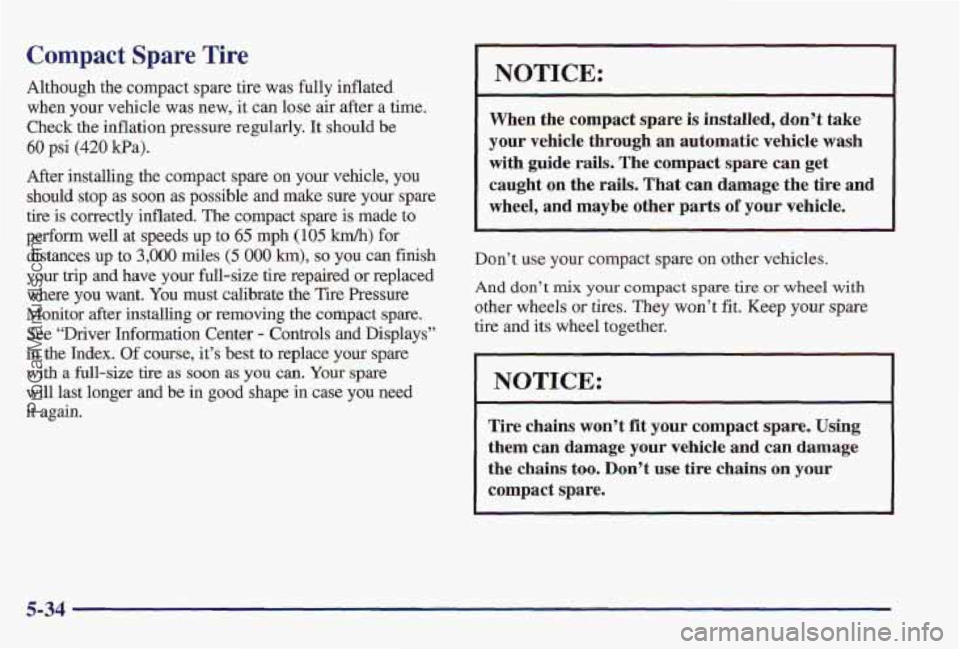
Compact Spare Tire
Although the compact spare tire was fully inflated
when your vehicle
was new, it can lose air after a time.
Check
the inflation pressure regularly. It should be
60 psi (420 Ha).
After installing the compact spare on your vehicle, you
should stop as soon
as possible and make sure your spare
tire is correctly inflated.
The compact spare is made to
perform well
at speeds up to 65 rnph (105 kdh) for
distances up to
3,000 miles (5 000 krn), so YOU can finish
your trip and have your full-size tire repaired or replaced
where
you want. You must calibrate the Tire Pressure
Monitor after installing
or removing the compact spare.
See “Driver Information Center - Controls and Displays”
in
the Index. Of course, it’s best to replace your spare
with a full-size tire as soon as you can. Your spare
will last longer and be in good shape in case you need
it again.
NOTICE:
When the compact spare is installed, don’t take
your vehicle through an automatic vehicle wash
with guide rails. The compact spare can get
caught
on the rails. That can damage the tire and
wheel, and maybe other parts
of your vehicle.
Don’t use your compact spare on other vehicles.
And don’t mix your compact spare tire or wheel with
other wheels or tires. They won’t fit. Keep your spare
tire and its wheel together.
NOTICE:
Tire chains won’t fit your compact spare. Using
them can damage your vehicle
and can damage
the ‘chains too. Don’t use tire chains on your
compact spare.
5-34
ProCarManuals.com
Page 269 of 419
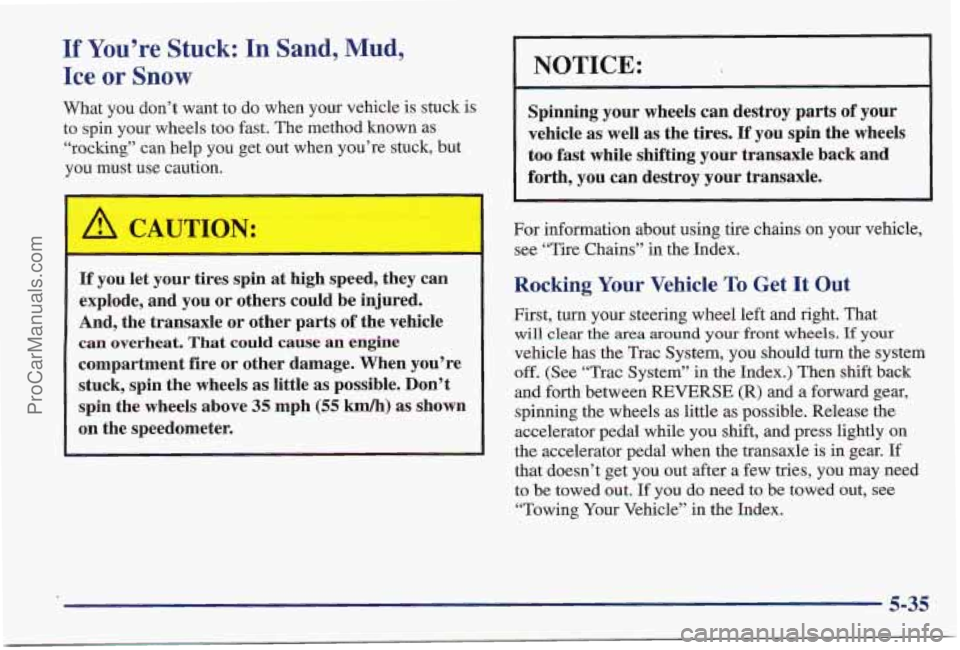
If You’re Stuck: In Sand, Mud,
Ice or
Snow
What you don’t want to do when your vehicle is stuck is
to spin your wheels too fast. The method known as
“rocking” can help you get out when you’re stuck, but
you must use caution.
L
If you let your tires spin at high speed, they can
explode, and you or others could be injured.
And, the transaxle or other parts
of the vehicle
can overheat. That could cause an engine
compartment fire or other damage. When you’re
stuck, spin the wheels
as little as possible. Don’t
spin the wheels above
35 mph (55 km/h) as shown
on the speedometer.
NOTICE:
Spinning your wheels can destroy parts of your
vehicle as well as the tires.
If you spin the wheels
too fast while shifting your transaxle back and
forth, you can destroy your transaxle.
For information about using tire chains on your vehicle,
see “Tire Chains” in the Index.
Rocking Your Vehicle To Get It Out
First, turn your steering wheel left and right. That
will clear the area around your front wheels. If your
vehicle has the Trac System, you should turn the system
off. (See “Trac System” in the Index.) Then shift back
and forth between REVERSE (R) and
a forward gear,
spinning the wheels as little as possible. Release the
accelerator pedal while you shift, and press lightly on
the accelerator pedal when the transaxle
is in gear. If
that doesn’t get you out after a few tries, you may need
to be towed
out. If you do need to be towed out, see
“Towing Your Vehicle” in the Index.
ProCarManuals.com
Page 270 of 419
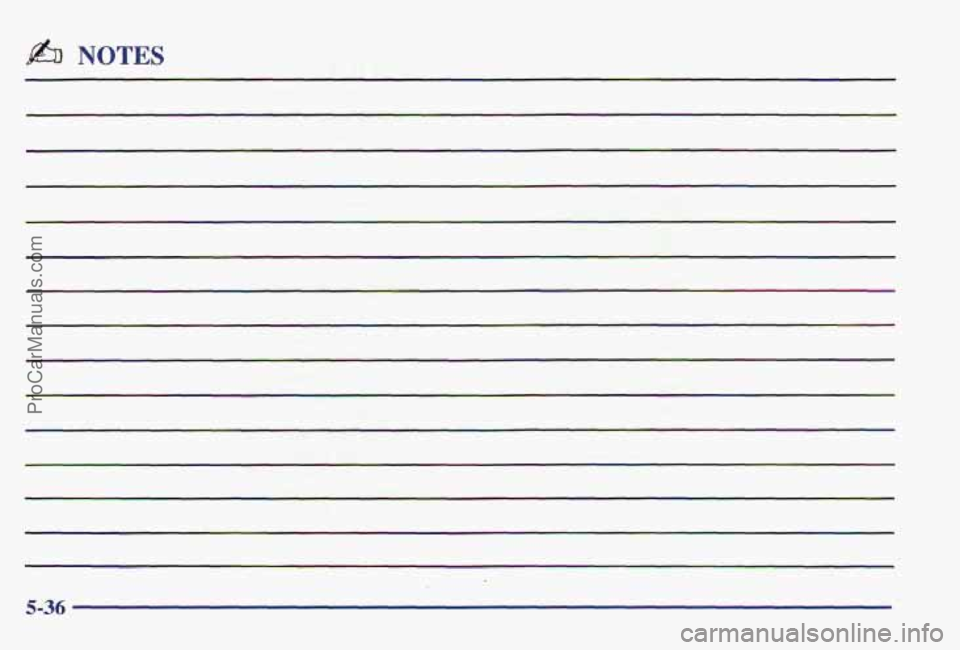
b NOTES
5-36
ProCarManuals.com